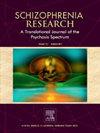Thalamic hyperperfusion in early schizophrenia: Associations with cognitive deficits and negative symptoms
IF 3.5
2区 医学
Q1 PSYCHIATRY
引用次数: 0
Abstract
Objective
Thalamic abnormalities have been associated with clinical and cognitive symptoms of schizophrenia, yet their role in the early stages of the disorder remain unclear. This study aimed to examine and compare thalamic perfusion differences between first-episode schizophrenia (FES) and early-course schizophrenia (ECS), along with their associations with cognitive performance and symptom severity.
Methods
This study included 100 unmedicated schizophrenia patients aged 19–30: 50 FES and 50 ECS (<5 years, ≥2 episodes). Symptom severity was assessed with PANSS, and cognitive function was evaluated using the 5-KOG battery. All participants underwent brain SPECT and thalamic perfusion was analyzed using MIMneuro® software with whole-brain normalization and Z-score extraction. Group comparisons were performed using Chi-square tests, and associations between thalamic perfusion, cognition, and symptom severity were assessed using Spearman's rank-order correlations.
Results
Compared to FES patients, those with ECS showed significantly higher thalamic perfusion (P = 0.032). In the FES group, global thalamic hyperperfusion was negatively correlated with verbal fluency (ρ = −0.374, P = 0.007), while in the ECS group, right thalamic perfusion was positively correlated with negative symptom severity (ρ = 0.373, P = 0.008).
Conclusion
Thalamic hyperperfusion, especially in the right hemisphere, may reflect early cognitive and clinical changes in schizophrenia. Associations with negative symptoms and verbal fluency highlight its potential as a functional biomarker. These findings support the value of early-stage imaging and warrant further longitudinal research.
早期精神分裂症的丘脑高灌注:与认知缺陷和阴性症状的关系
目的丘脑异常与精神分裂症的临床和认知症状有关,但其在精神分裂症早期阶段的作用尚不清楚。本研究旨在检查和比较首发精神分裂症(FES)和早期精神分裂症(ECS)之间的丘脑灌注差异,以及它们与认知表现和症状严重程度的关系。方法本研究纳入100例19-30岁未服药的精神分裂症患者,其中FES 50例,ECS 50例(≥5年,≥2次发作)。用PANSS评估症状严重程度,用5kog电池评估认知功能。所有参与者都接受了脑SPECT和丘脑灌注分析,使用MIMneuro®软件进行全脑归一化和z评分提取。采用卡方检验进行组间比较,采用Spearman秩序相关性评估丘脑灌注、认知和症状严重程度之间的相关性。结果与FES患者相比,ECS组丘脑灌注明显增加(P = 0.032)。FES组整体丘脑高灌注与言语流利度呈负相关(ρ = - 0.374, P = 0.007),而ECS组右侧丘脑高灌注与负症状严重程度呈正相关(ρ = 0.373, P = 0.008)。结论丘脑高灌注,尤其是右半球高灌注,可能反映精神分裂症患者早期认知和临床变化。与阴性症状和语言流畅性的关联突出了其作为功能性生物标志物的潜力。这些发现支持了早期成像的价值,并为进一步的纵向研究提供了依据。
本文章由计算机程序翻译,如有差异,请以英文原文为准。
求助全文
约1分钟内获得全文
求助全文
来源期刊

Schizophrenia Research
医学-精神病学
CiteScore
7.50
自引率
8.90%
发文量
429
审稿时长
10.2 weeks
期刊介绍:
As official journal of the Schizophrenia International Research Society (SIRS) Schizophrenia Research is THE journal of choice for international researchers and clinicians to share their work with the global schizophrenia research community. More than 6000 institutes have online or print (or both) access to this journal - the largest specialist journal in the field, with the largest readership!
Schizophrenia Research''s time to first decision is as fast as 6 weeks and its publishing speed is as fast as 4 weeks until online publication (corrected proof/Article in Press) after acceptance and 14 weeks from acceptance until publication in a printed issue.
The journal publishes novel papers that really contribute to understanding the biology and treatment of schizophrenic disorders; Schizophrenia Research brings together biological, clinical and psychological research in order to stimulate the synthesis of findings from all disciplines involved in improving patient outcomes in schizophrenia.
 求助内容:
求助内容: 应助结果提醒方式:
应助结果提醒方式:


